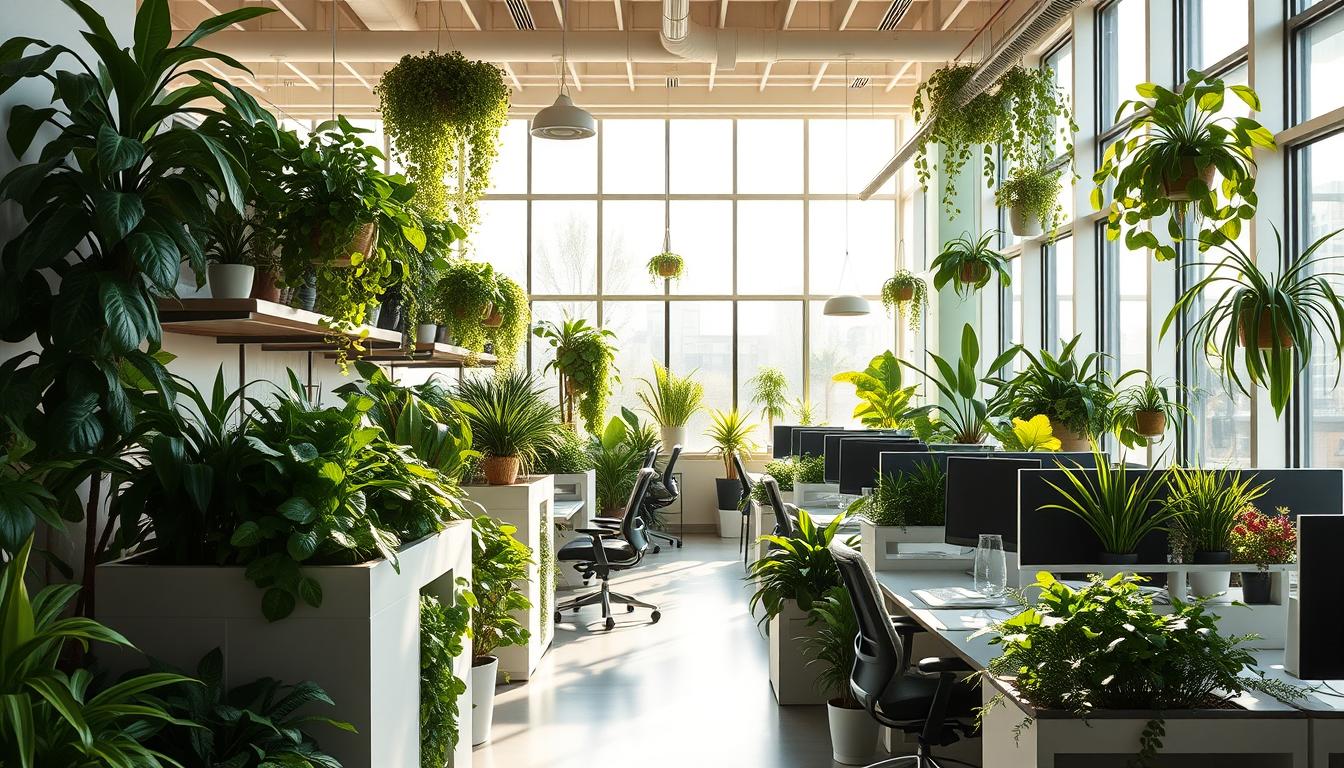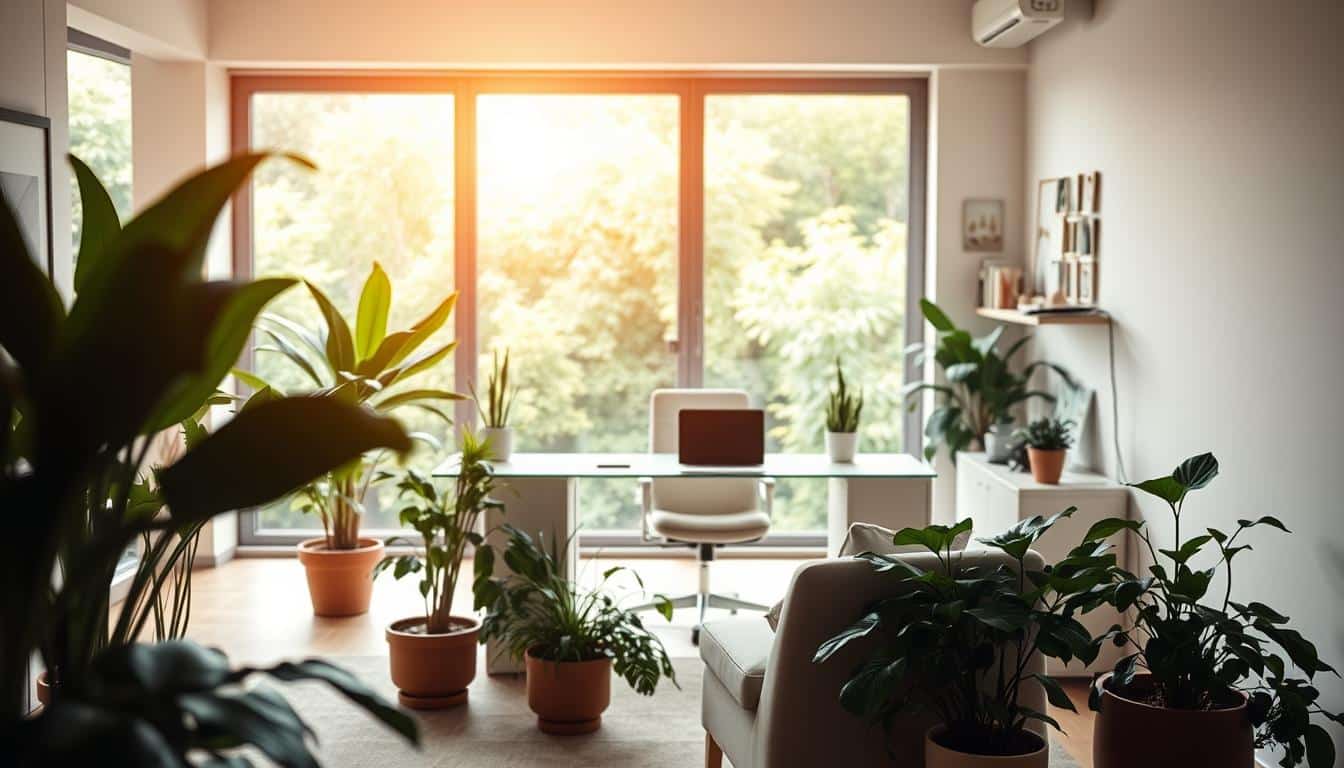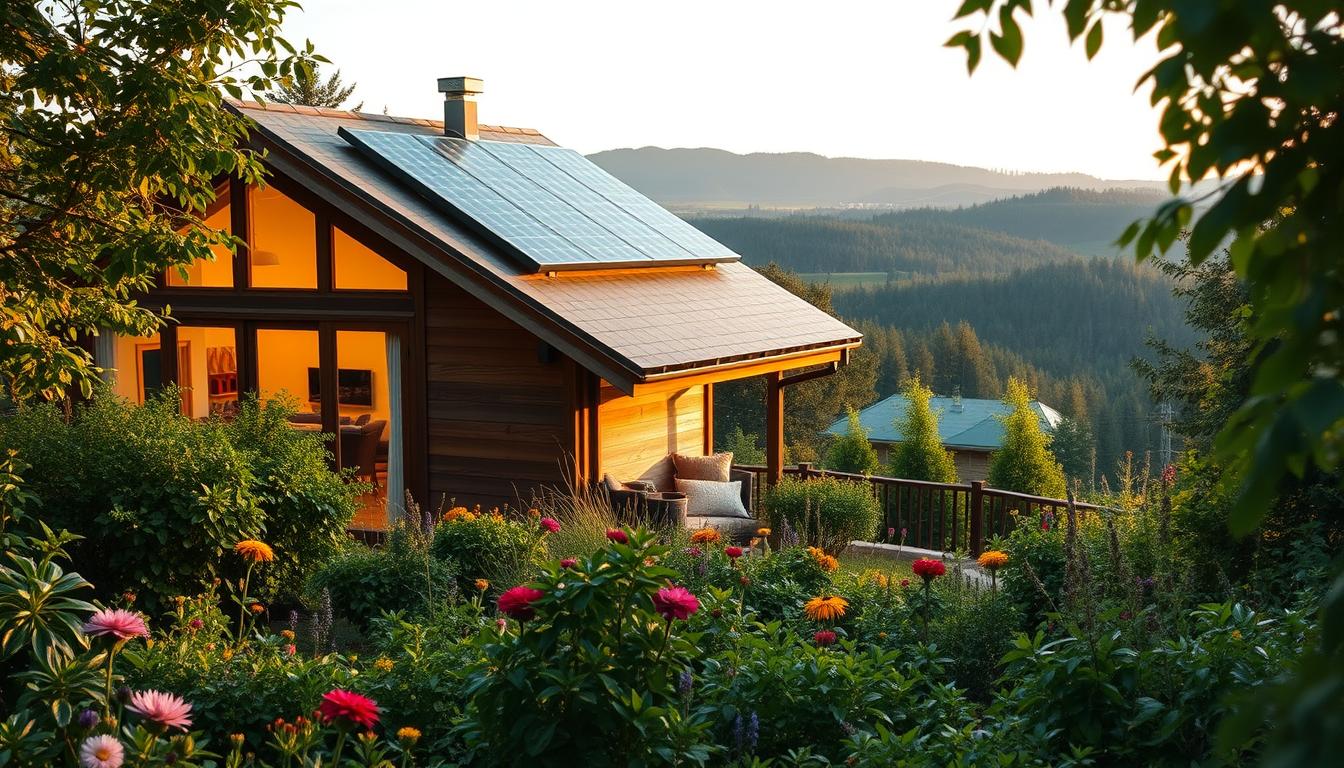Natural air buffer zones are becoming popular in today’s work areas. These zones improve air quality using indoor plants and modern ventilation. They remove pollutants and allergens, boosting employee health. This article talks about their benefits, how they fit with nature-inspired design, and potential challenges.
Introduction to Natural Air Buffer Zones
Natural air buffer zones are a smart way to make indoor spaces, like offices, better. With cities getting crowded, these zones are more important than ever. They bring fresh air and nature into work areas.
Having natural ventilation is key. By adding design features that open to the outside, companies can make workspaces more comfortable. This not only purifies the air but also helps employees feel and work better. Adding plants and natural light boosts mood and efficiency, creating a healthier office.

Many organizations are looking at natural air buffer zones as a way to improve air quality and comfort. This approach helps blend nature with workspaces. It creates a productive and healthy environment for office employees.
The Importance of Air Quality in Workspaces
High air quality is key for employees’ well-being. Poor air quality leads to health problems and lowers work productivity. Knowing how air quality affects the workspace is vital for a healthier and more productive environment.
Effects of Poor Air Quality on Employee Health
Poor indoor air quality can make employees sick. They might get headaches, feel tired, or have trouble breathing. Offices have pollutants like chemicals, mold, and dust. These can make problems worse. Bad ventilation ups the risk of running into these bad elements, hurting employees’ health and morale.
Link Between Air Quality and Productivity
Air quality and productivity at work are closely linked. Bad air makes employees uncomfortable and less focused. This can lead to worse job performance. Improving air flow and adding plants can make air better. This helps employees work better.
Creating Natural Air Buffer Zones in Offices
Businesses can improve indoor air by setting up natural air buffer zones. These zones use nature to make workspaces better. By adding office plants and green spaces, the environment becomes cleaner and more calming.
Having good ventilation is key to these natural zones. Adding windows that open helps bring in fresh air. This clears out indoor air pollutants. Also, arranging the office to help air move boosts quality and encourages teamwork.
It’s vital to choose the right plants for the office. Pick plants that grow well indoors and cleanse the air. These green spaces not only look good but also make the office more pleasant and engaging for everyone.
Benefits of Incorporating Plants into Workspaces
Adding plants to offices helps both workers and the whole place feel better. Greenery makes spaces look nice and keeps the air healthy. It helps people’s minds and lowers stress at work.
Enhancing Mood and Reducing Stress
Work can make people feel stressed because of tight schedules and hard tasks. But, adding plants makes things calmer and helps everyone feel better. Research shows that green spaces lift spirits a lot.
They help create a peaceful place that makes relaxation easy. This makes workers more dedicated and productive.
Boosting Creativity and Focus
Studies link nature to better thinking and creativity. Plants in a work area help with mental health and make people more creative. Workers get more inspired and can concentrate better in a green environment.
This bond with nature helps bring out new ideas. It makes working together better, helping creativity and teamwork grow.
Natural Air Buffer Zones in Offices
Natural air buffer zones are key for healthy office environments. They improve air quality and enhance workspace wellness. By adding plants, companies make their offices look better and feel healthier. This not only clears out toxins but also lowers noise, making the atmosphere welcoming.
How These Zones Promote Healthy Work Environments
Having these zones helps cut down on air pollution, which is good for employee health. With cleaner air, people can focus better and feel less tired. This boosts how much they can do. Offices with plants are less stressful and more peaceful. This environment supports creativity and teamwork among workers.
Types of Greenery Suitable for Offices
Picking the right plants is very important. Here are some great choices for office plants:
- Snake Plant: Known for its air-purifying qualities and resilience.
- Pothos: Effective at removing pollutants and easy to care for.
- Spider Plant: A robust choice that thrives in various indoor conditions.
- Peace Lily: Adds elegance while filtering harmful chemicals.
- Boston Fern: Ideal for improving humidity levels and air quality.
Fresh Air and Ventilation Solutions
Good air flow is key to a healthy office. Adding natural venting makes a space where fresh air comes in easily. This improves the air we breathe. By opening windows when the weather’s good, designing for good cross-ventilation, and using the building’s layout for airflow, we can support green goals. These steps bring outside air in. This is crucial for cutting down on indoor pollutants and making employees feel better.
Natural Ventilation Strategies
There are many ways to bring fresh air inside:
- Utilizing operable windows to allow fresh air in.
- Incorporating skylights for passive ventilation.
- Positioning vents strategically to promote cross-ventilation.
- Designing space layouts that support open air pathways.
Importance of Air Flow in Workspaces
Good air movement is important for comfort and getting work done. Offices with good ventilation offer many benefits:
- Reduction of airborne pollutants and allergens.
- Improvement of overall employee health and satisfaction.
- Boosting energy levels and focus among staff.
Integrating Biophilic Design Elements
Biophilic design blends nature into architecture, boosting well-being at work. Spaces filled with natural elements make us feel closer to the natural world. Using biophilic ideas, workplaces become more creative and productive.
Adding natural materials, green plants, and water makes offices look better. These elements help people feel mentally better and more fulfilled at work. Having the right mix of light, space, and nature shapes brings calm and sparks inspiration in today’s offices.
Case Studies of Successful Implementations
Modern coworking spaces are at the forefront of creating healthy work zones. These areas help both the mind and body feel better. Through the use of nature, these workspaces show how designs affect worker happiness and efficiency. Various city examples show the positive outcomes of adding plants, areas for fresh air, and nature-responsive designs.
Examples from Modern Co-working Spaces
Many coworking places show how natural air zones work well. Some notable examples are:
- WeWork locations are full of plants. This makes the office feel fresh and helps people work together better.
- Spaces has big windows and spaces open to the air. This improves air flow and makes a healthier workspace.
- The Yard uses natural designs like walls of plants. This shows how creative offices can be both healthy and productive.
Challenges in Creating Effective Buffer Zones
Creating natural air buffer zones has clear benefits. Yet, various barriers complicate their establishment. Urban areas often have limited space. This makes it hard to add green areas without causing disruptions or reducing workflow. Also, laws and building codes can limit what plants or structures can be used.
But the issues don’t stop with space or laws. Budget constraints can limit the choice and upkeep of greenery. This may lead to poorer air quality improvements. Companies also need to consider how these green zones fit with the office’s look and use. Overcoming these challenges requires good planning and resources. This way, businesses can set up meaningful and effective natural air buffer zones.
Conclusion
Air buffer zones are changing the way we think about office design. They bring in plants and better air systems. This helps keep employees healthy and boosts their work and happiness. It shows we know how important clean air is in making better work places.
More companies want healthy work spaces now. They are looking to add these air buffer zones. Those who do will see big rewards. They will have happier, more productive teams.
Using air buffer zones is smart and looking ahead. They help offices be ready for future changes. This makes them key in new office designs.



